6th
- 15th August 2012
Cambodia
7853 - 8175km
Siem Reap – Skuon – Sampong Chey - Skun – Phnom Penh
Shadows over Cambodia
There is a weight to the past in Cambodia. As we came through the
border we could feel the inertia in our stomachs, feel the distant pressure drawing things its way. Everyone knows about it. This black horror that
swallowed everything up, and still pulls at the country today.
Even cycling through these sunshine scenes of rural life; kids waving
and farmers smiling, lean back in the saddle and gaze across the
sparkling rice fields, we know there's something bad beneath it all.
The glacial crunch of bones beneath the surface. There's no avoiding
it. The trauma shook every life across the country, and not so long ago. After our week in Siem Reap
we kicked off and headed east, towards Phnom Penh, and the killing
fields.
The ride from Siem Reap to Phnom Penh was a hot, fast, three day ride
along the highway as it cuts a broad arc over the great lake. Early
starts cleared up some kilometres before the heat got a hold of the
day, and frequent breaks in the shade with a cold coconut made
the journey a pretty pleasant one. We'd sit around for half an hour
watching life unfold in these hairdryer-hot towns; chickens rummaging
around our feet, horses hauling wooden-wheeled
carts, and in the dust across the road taut faced cows lay scowling
in the sun. Nice and easy.
We eased off on our hardcore camping ethic in Cambodia too. Hotels,
motels and hostels were back on the menu. In part this was down to a
conversation we'd had with a restaurant owner in Siem Reap. He'd
taught us how to ask in Cambodian “Can we pitch a tent here”, but
he'd thrown in some advice too. Cambodia is a poor country,
he reminded us, and unless we found ourselves in a bind it was
probably right to spend a couple of extra dollars and find ourself
some lodging when we could, and help out the local businesses.
The other, of course, was that it was bloody nice shelving the idea
of camping in the heat being barked at by dogs.
But of course, getting into binds is what we do best, so it wasn't
long before the tent came out.
We were lucky on our first night out of Siem Reap, and by chance ended up in a town with accommodation. The next night though we weren't so lucky. A late afternoon downpour pinned us in a village while the damp afternoon slipped into twilight. There was no accommodation here. There hadn't been any since we'd left our hotel that morning. We were too far from any large towns to make a push for it, so as soon as we saw the familiar gilded rooftop of a temple peeping through the trees we pedalled inside.
We were lucky on our first night out of Siem Reap, and by chance ended up in a town with accommodation. The next night though we weren't so lucky. A late afternoon downpour pinned us in a village while the damp afternoon slipped into twilight. There was no accommodation here. There hadn't been any since we'd left our hotel that morning. We were too far from any large towns to make a push for it, so as soon as we saw the familiar gilded rooftop of a temple peeping through the trees we pedalled inside.
We were greeted by a crowd of waving children in orange robes. A few
dozen of them came pouring out of the prayer hall to cheer and smile
and stare at these strangers who'd arrived on the grounds. An older
monk - although still a few years younger than us - stepped forward
and introduced himself as Leedas. He showed us into the prayer hall
that would be our home for the night, a gloomy place, there was no electricity and the thunderclouds had choked
out the last of the day's light. Leedas
lit the candles, and we got to work setting up our tent as bats
chattered and swooped in the rafters above.
There was a strange Neverland quality about the place. All of the monks were younger than us. All of them. We kept expecting to bump into an elder when we went for a shower, or as we took a stroll around the grounds at dusk, but there were none. With all the distractions of getting set up for the night it took us a little while to click, and realise why.
We were face to face with one of the many scars left on the country
by the Khmer Rogue, the communist regime that took power in 1975 and,
by the time they were driven out in 1979, had managed to starve, hack
and bludgeon two million people - a quarter of the population - into
their graves. Anybody who did not fit in with Pol Pot's vision for
the country was rounded up, tortured, and executed. Teachers,
artists, doctors, anybody with an education, and of course, monks. So
here we were, in a temple full of children who were left to pick up
the pieces.
Cambodia got it bad after the collapse of the Angkor Empire. For
centuries Thailand and Vietnam fought over it, gnawed at the borders,
colonised, left, and colonised again. Were it not for the French
stepping in in 1863 Cambodia would have almost certainly been
swallowed up by its rivals and lost.
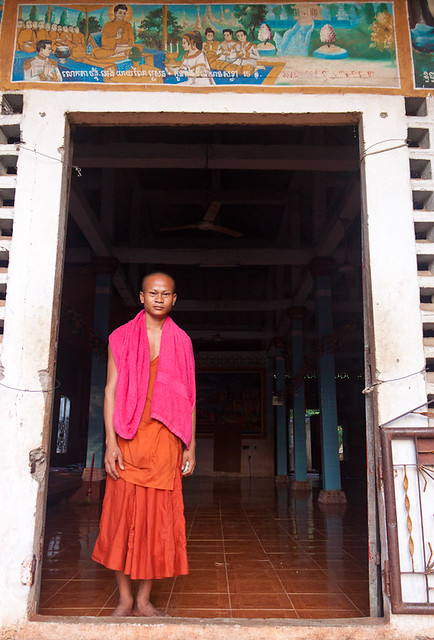 |
| Leedas |
This 'protectorate', as the French rule was known, ended in 1953,
but worse was to come for Cambodia. The Vietnam war was spilling over
the border, and an army of communist guerilla fighters were gradually
snapping up areas of the countryside. Very little was thought of
these red Khmers, or 'Khmer Rogue', because they were nothing
compared to the encroaching Viet Cong or the might of America, any of
which might overthrow Cambodia's fragile sovereignty.
A strong government may have prevented the horror that was looming,
but Cambodia was blighted by rulers of the worst kind. Public money
flowed into their pockets, they sanctioned their own mass killing of
hundreds of ethnic Vietnamese, and they imprisoned and tortured their
political enemies, driving many moderates out of the cities to join
the ever growing ranks of extremists in the jungle.
Such a rotten government never lasts. Corrupt army officers had
fabricated recruits in order to pocket their wages, while making it appear that they had the numbers to fight the enemy. Worse still, some even sold their weapons
to the Khmer Rogue to pocket the cash themselves. Disaster was
imminent, but the government just sank their teeth into the country
and fed.
Bugger!
 The tent was absolutely sweltering that night.. We
were hungry too, since there had been nowhere to eat so we'd had to
make do with a tiny tin of rice meal from our supplies. Sleep had not
come easily, and we woke early, tired and hungry, and set off into
the morning.
The tent was absolutely sweltering that night.. We
were hungry too, since there had been nowhere to eat so we'd had to
make do with a tiny tin of rice meal from our supplies. Sleep had not
come easily, and we woke early, tired and hungry, and set off into
the morning.
After a quick 15km pedal we came to the junction town of Skun, and a
chronic beige restaurant serving noodles.
Although seemingly a nowhere junction town, Skun is famous for a
rather unusual delicacy that comes piled
high in wicker baskets around the market stalls.
Tarantulas.
Deep fried tarantulas.
Yet another symptom of the Khmer Rogue years this one, as their disastrous agricultural policies pushed the country towards starvation, forcing people to find whatever they could to sustain them. Locals here found large spiders burrowing in the ground so they dug them up, fried them, and found they really rather liked them. We figured we'd have to give them a go.
Tarantulas.
Deep fried tarantulas.
Yet another symptom of the Khmer Rogue years this one, as their disastrous agricultural policies pushed the country towards starvation, forcing people to find whatever they could to sustain them. Locals here found large spiders burrowing in the ground so they dug them up, fried them, and found they really rather liked them. We figured we'd have to give them a go.
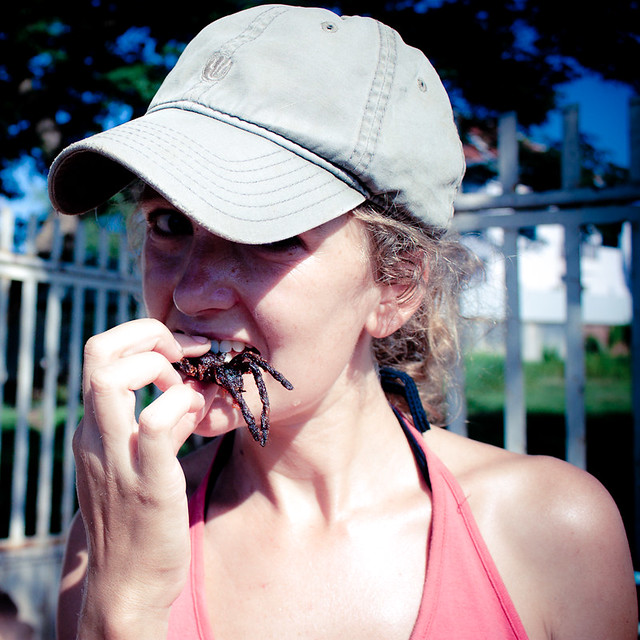 But as we sat there shovelling noodle soup something scurried up
Liv's arm. She swatted it, plucked it off, and saw to her horror that
it was a bed bug! Now, bed bugs are notoriously shy creatures and do
not venture outside during the day. They also tend to stick to beds,
which makes their appearance on a restaurant table in the morning very unusual. Liv speculated that it may have come from her bags, as
she'd been rummaging around inside just before the incident. Could
bed bugs have infiltrated our gear? It would be a serious problem if
they had. Very serious. Once they get a hold in there they're nigh on
indestructible, only very high temperatures - or squishing them
between fingernails – can kill them. If they'd lain eggs in there
our whole kit could be compromised.
But as we sat there shovelling noodle soup something scurried up
Liv's arm. She swatted it, plucked it off, and saw to her horror that
it was a bed bug! Now, bed bugs are notoriously shy creatures and do
not venture outside during the day. They also tend to stick to beds,
which makes their appearance on a restaurant table in the morning very unusual. Liv speculated that it may have come from her bags, as
she'd been rummaging around inside just before the incident. Could
bed bugs have infiltrated our gear? It would be a serious problem if
they had. Very serious. Once they get a hold in there they're nigh on
indestructible, only very high temperatures - or squishing them
between fingernails – can kill them. If they'd lain eggs in there
our whole kit could be compromised.
Well, there wasn't much we could do now. We'd check when we got to
Phnom Penh. Liv was very worried though, because she reacts badly to their
bites and they are pretty much her arch nemesis. I tried to reassure her,
and suggested we might take our mind off things by going and finding
a deep fried tarantula, and eating it.
They were far less crispy than we'd imagined. Our spider kind of
flopped in our palms, his blank
dead eyes holding us with something of a disapproving stare. “Now
then” they seemed to say “You think this is appropriate
behaviour do you?” It's true, when you look at a spider it's very
hard to make the cognitive leap to 'food'.
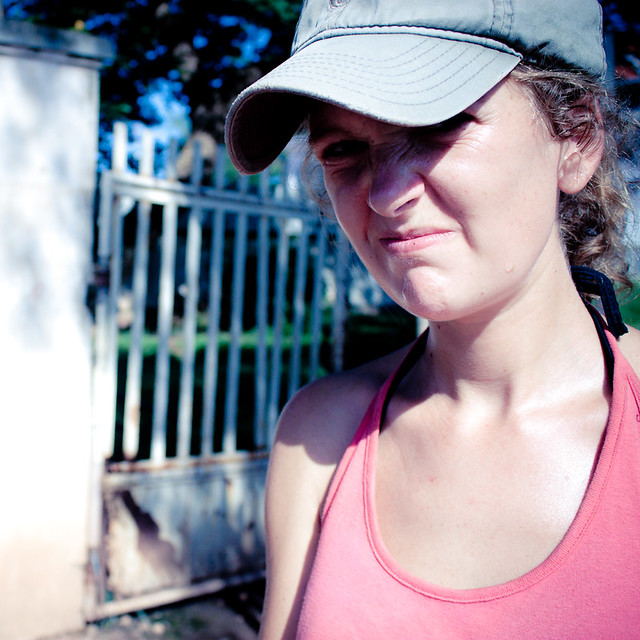 Well, you've got to try it once I suppose, so we got to work chewing
its legs off. As with the crickets in Mae Sot, it didn't taste too
bad because it didn't really taste of anything. It's fried fat, with
the remnants of a tasteless bug inside. Next time you're chewing on a
bit of deep-fried sinew on a chicken leg, you're tasting tarantula.
Remember that.
Well, you've got to try it once I suppose, so we got to work chewing
its legs off. As with the crickets in Mae Sot, it didn't taste too
bad because it didn't really taste of anything. It's fried fat, with
the remnants of a tasteless bug inside. Next time you're chewing on a
bit of deep-fried sinew on a chicken leg, you're tasting tarantula.
Remember that.
Apparently there are some other bits of the body you can eat, but
for the unskilled you may pop some kind of bladder of bitter brown
goo, so we just stuck to the legs. An eight legged feast of spider
drumsticks. Breakfast of champions.
Capital company
Capital company
The final stretch of road into the capital was appallingly bad. We
spent several hours squeezing our way up a clogged, narrow road that
was blasted by a headwind packing sand. Horns barked, cars drove
right at us, and the temperature was unbearable. Thankfully Liv
spotted a turning and we escaped from this hell pass to a quiet track
alongside the Mekong. For an hour we bumped along this country scene
of cows, kids and fishermen, that got us within striking distance of
the city centre.
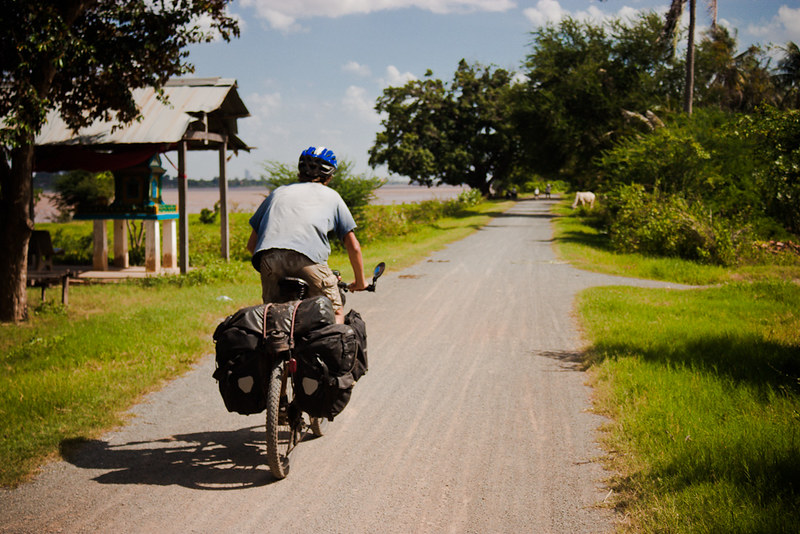 |
| Our first glimpse of the Mekong! |
After so long in rural Cambodia it was a bit of a shock finding
ourselves in a bustling city. We pedalled southwards, hemmed in by
cars and motorbikes, and finally found ourselves a
touristy area tucked away in a grid of side streets.
Phnom Penh is not a particularly nice looking place, but then
neither is it terribly bad either. Imitation French apartments line
the streets, scruffy and mildewed but nice enough to look at. Markets
swallow up whole streets, while others are commandeered exclusively
by laundrettes or tailors or some other profession. The kids are
still around, happy as ever, waving and shouting between their
favourite game of 'throw a flip flop down the street'. Street dogs
canter by, and the roads surge with motor-scooters. Life is busy
here, but not as rushed as other cities.
Our hotel was a very nice place, a little expensive at $8 a night,
but with a big comfy bed, bathroom and balcony restaurant, it was
worth it. But of course we had no time to relax, because we had bed
bugs to deal with.
We brought all our gear into the bathroom to quarantine it, and then
over the course of two days we went through absolutely everything -
pockets, seams, tool kits, food containers, documents, everything
– to try and find any signs of infestation.
We found another bug the day we arrived, but again it seemed to be
on the outside of the bags, which was very strange behaviour for a
creature of dark crevices. We had a good look at the little bastard,
and then incinerated him.
Following our examination, and after some online research, we discovered that there was another
species of bug, very similar in appearance to bed bugs but which live on bats. Bat bugs. We had ourselves an explanation to the mystery, since
there had been plenty of bats roosting right above our bags the night
before.
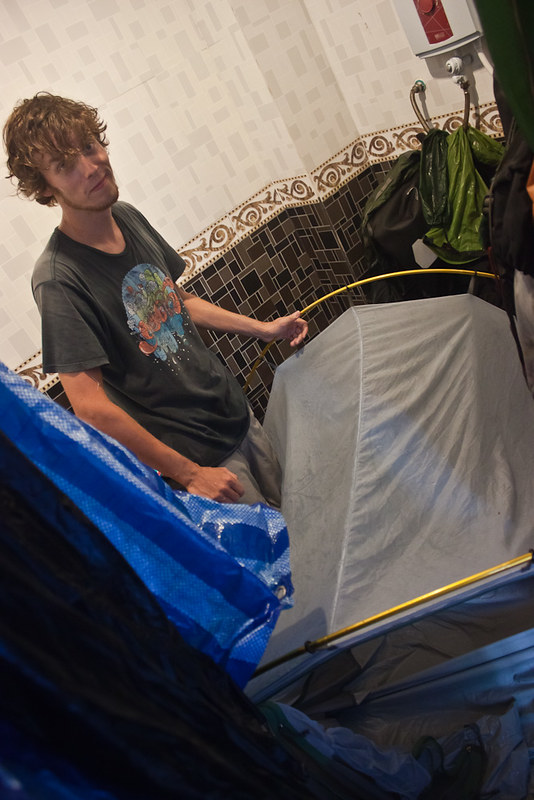 |
| Cleaning out the tent in the bathroom |
Although we read that bat bugs cannot breed without the presence of
bats' blood we didn't take any chances. After going through our
gear we took all our clothes to the laundrette for a high temperature
wash, then got to work scrubbing out the tent, blankets, inflatable
mattresses and sleeping bag. That was a few weeks ago now, and so far
there's been no more sign of them. Phew!
During our epic clean we found time to apply for our Chinese visa. It would take 5 days to come through, so we had a bit of time to kill.
Luckily for us our hostel had a fantastic host of travellers – Marie and Melana who were volunteering with the sisters at
a nearby orphanage; Camille, who was on a solo backpacking mission;
and Illia, an American who'd grown up in Russia during the fall of
the Soviet Union and who now worked for an NGO tackling extremism.
Very interesting bunch, plenty to talk about as you can imagine, and
we wiled away our evenings with them, eating out, swilling beers, and sorting out the world's problems.
Two of the big draws
for tourists in Phnom Penh are relics of the Khmer Rogue days. The
tuk-tuk drivers outside our hotel knew this, and we were often
greeted by a cheerful “Killing fields?” as we set out in the
morning. Phnom Penh was at the heart of it really, and its fall to
the Khmer Rogue in 1975 signalled the beginning of the darkest years.
The government had fled, or been killed, or gone into hiding by the
time the black-clad troops of the Khmer Rogue arrived in the city.
Many Cambodians knew people who had fled into the country to fight,
but they had heard some terrible stories too. The atmosphere then was
one of trepidation as the soldiers marched through the streets,
firing their weapons into the air and shouting revolutionary slogans. Might this new regime be an improvement on the last?
 |
| Despite everything, this style of advertisement is apparently still appropriate. |
Cambodians with aspirations above serfdom were not only unwanted by the
regime, they were regarded as a threat, something to be dug out and
destroyed. Their contempt for life was made clear early on when Pol
Pot issued this chilling message over the radio: Two million peasants
were needed for his new agrarian utopia, as for the rest “To keep
you is no benefit. To destroy you is no loss.”
People began to disappear, taken away for interrogation
or re-education. Perhaps you had been seen speaking to a foreigner a
few years ago, or did you teach a class in your village, or
maybe somewhere in a locked room somebody had screamed out your name to put an end to their torture.
Whatever the reason, you weren't ever to know. You'd disappear in the
night, and find yourself at one of the detention centres with no idea
of the crime you were charged with.
These centres sprung up all across Cambodia, but the most notorious
of these was in Phnom Penh itself, Tuol Sleng, an old school
converted for the purpose.
Liv and I walked the kilometre or so down the road to the building,
a sombre place surrounded by high fences and barbed wire right in the middle of a residential area. Photographs
show the corpses that were found here after the liberation. Bloated bodies
strapped to beds, bloodied pick axes lying beside them.
Elsewhere whole floors of classrooms have been swallowed up by compact cells constructed from brick and timber where thousands of people
spent their final months.
The regime was meticulous about keeping records. Everyone who came
into this prison was photographed and registered, as if by
formalising these murders they were justifying them. Today you can see all
the thousands of frightened faces of men, women and children staring
back at you from displays around the building. Elsewhere there are
photographs of prisoners in the midst of their torture, the life gone
from their eyes, blood everywhere. Of an estimated 20'000 people that
came through this prison, less than 200 got out alive.
Confessions were needed to legitimise what was to come, and so prisoners were taken in to converted classrooms where they were
electrocuted, drowned, beaten, hung, and had finger nails ripped out. If through all of this you could figure out the crime you were charged
with you would sign a statement admitting your guilt so the
torture would end and you could go back to your cell. Many people didn't, and died during interrogation.
Soon after your confession the call would come that you were going to be sent to a new work project. Your re-education was complete.
As night fell a truck would come to the gate, your name called out,
and you would be led inside, blind folded and with your hands tied. From
here the truck would bump its way along the pot holed roads and out
of town.
A few kilometres out of the city you would hear the sound of revolutionary songs blaring from speakers. The truck would stop, and you would be led up a small path in an area hidden by high walls. Soon after you would be made to kneel. No doubt many people knew by now. If the smell didn't
already reach you perhaps you could peer below your blindfold where hundreds of corpses crowded the ground below.
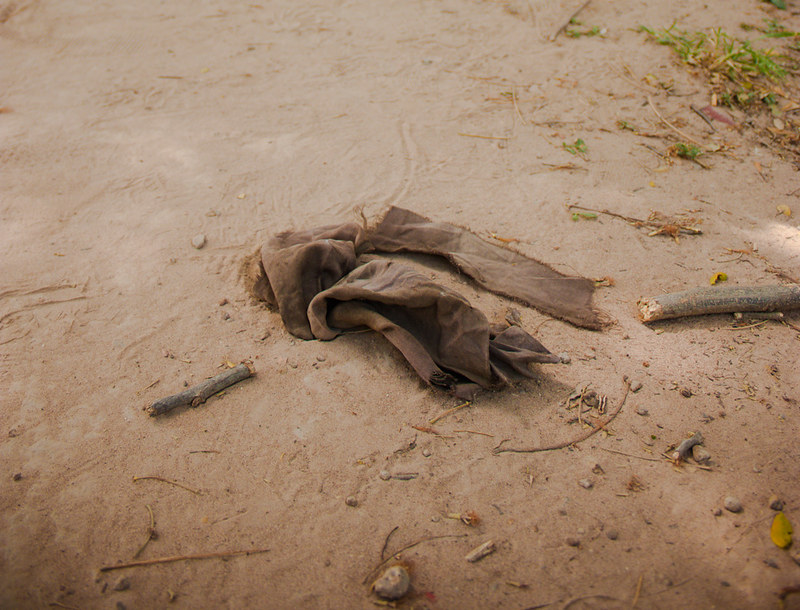 |
| Clothes of the victims protrude from the ground all around the site. |
Bullets were too precious to the Khmer Rogue, so the executioners had to use whatever they could find. Farming tools seem to have been popular; spades, pick axes, cart axles, but anything would do.
 |
| 'The Killing Tree' |
As we walked around the site of these old killing fields, and saw
the mass graves, the teeth and bones, it brought to mind a guy we had
met in Siem Reap. On our night out in town with Tim and Barbara, a
local by the name of Three-Eye had sat down next to us. Shrapnel wounds pocked his body, with a small one
above his right eye to which he owed his name. He got them fighting
the Khmer Rogue in 1989. Three-Eye spoke with a wildness, and he held
you with severe, watery eyes as he spoke. “I had thirty-seven
family members in 1975.” he said, “How many do you think were
left by the end?” There was a pause, and we shook our heads. He held
up five fingers. “When you go to the killing fields, and you see
the skulls piled up inside the memorial, you know that one
of those is my father.”
Built on twisted ideals, and propped up by fear, the regime soon
began to list and crack. The crops failed spectacularly, obviously,
as they were managed by untrained labourers with no farming
experience. Food became desperately scarce, and many hundreds of
thousands of people perished in the ensuing famine.
As this disaster unfolded the regime's paranoia swelled and
more and more people were gagged and dragged into their prisons to die.
Fear chewed through the ranks like rot. Their own members fell
under suspicion, and many, even the old prison guards, were sent to
be interrogated and butchered. Something had to give.
Pol Pot's fanaticism would be the final straw. In 1979 he took his rather feeble army to try and
attack the south of Vietnam – a country that had just emerged
victorious after thirty years of war and had at its disposal one of
the most highly trained and effective armies on earth. Encouraged by
Khmer Rogue deserters who begged assistance for their broken country,
the Vietnamese descended on Cambodia and quickly scattered the Khmer Rogue back into the jungle. The days of Pol Pot and the Khmer Rogue were over.
Almost.
For decades they kept up a campaign of murder and terror in the
countryside to thwart the democratision process in Cambodia,
although they needn't have bothered. Vietnam did do the
honourable thing in deposing of Pol Pot's regime, but they planted
puppet leaders that were assassinated whenever they were bold enough
to go against Vietnamese wishes.
 |
| Friendship bands around the posts of one of the mass graves. |
The killing fields were recently sold on a $15'000 a year contract to a Japanese company who make about $18'000 a month off it. Top party leaders have been implicated in the lucrative industry of illegal logging that is ruining the country's ecology.Worst of all though are the land grabs. Stories abound of armed government
forces driving locals from their land so they can
sell it to outside investors. Welcome to the bottom end of free
market economics.
Things don't look likely to change any time soon, frankly, but for
all the greed and oppression it is at least not anything approaching
the chaos of the Khmer Rogue years. But the funny thing about
Cambodia is that despite their appalling recent past, and the
sickening state of politics at the moment, this really is not what
the country is about. The killing fields shocked us, and the stained
floors of the torture rooms of Tuol Sleng are engraved in our
memories for good, but by far the most memorable thing about Cambodia
has been the wonderful people. Remember, they don't have to be like
this. Life is hard for the farmers, working from a very young age and many getting by on
much less than a dollar a day. Most people would be rather bitter
given a lot like that, but not this bunch. Cambodian's are probably
the warmest, friendliest bunch we've come across, so it would be
unfair and inaccurate to dwell too long on their black past.
After a week in the city our Chinese visas came through so we were
ready to move on. We had eyed up a track that followed the course of
the Mekong north for a few hundred kilometres and into the quiet
north east of the country. It was there that our final pedal through
Cambodia would take us, so we could see some more of that wonderful
friendliness and hospitality that defines a country dogged by bad
luck and bastards. We packed all our gear away, hauled the bags back
down the stairs, and saddled up for the next leg of our adventure.
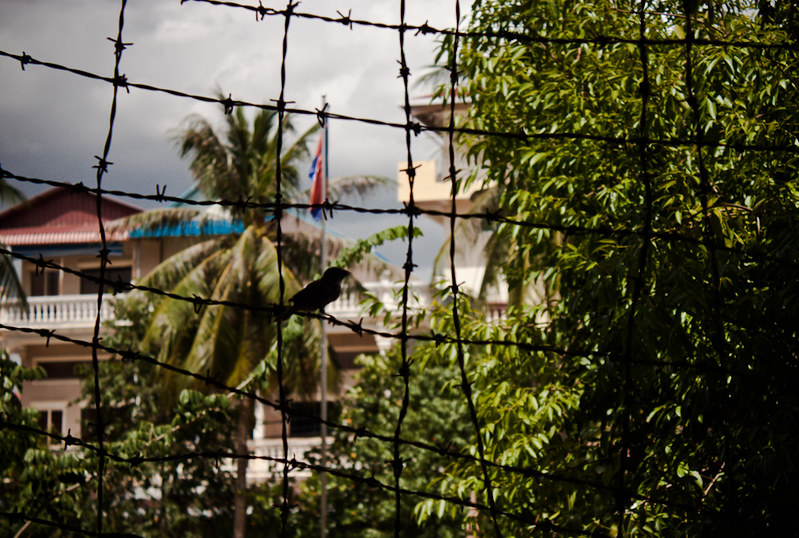



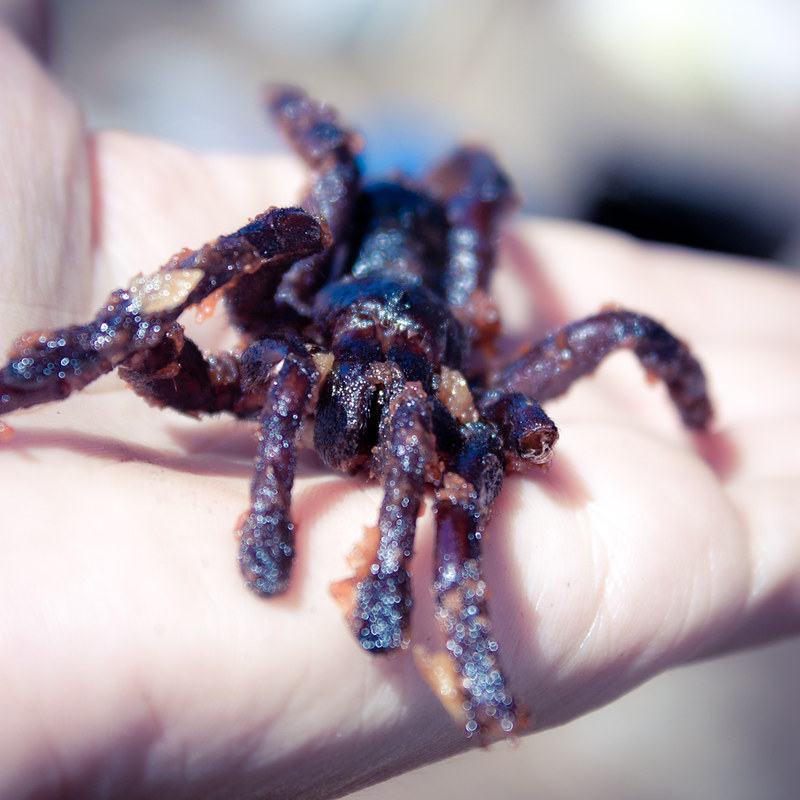
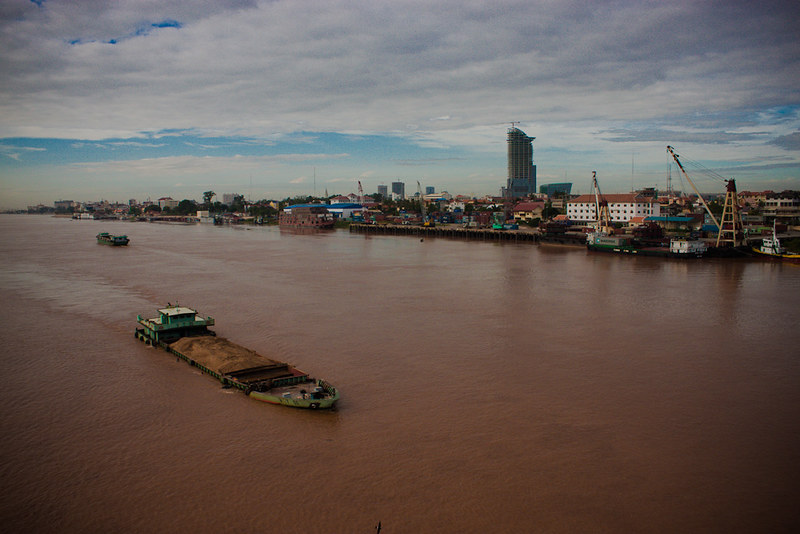


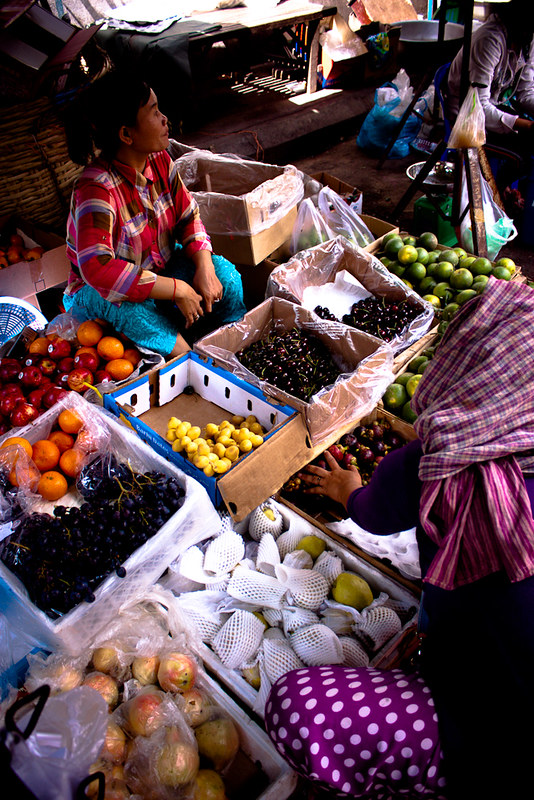


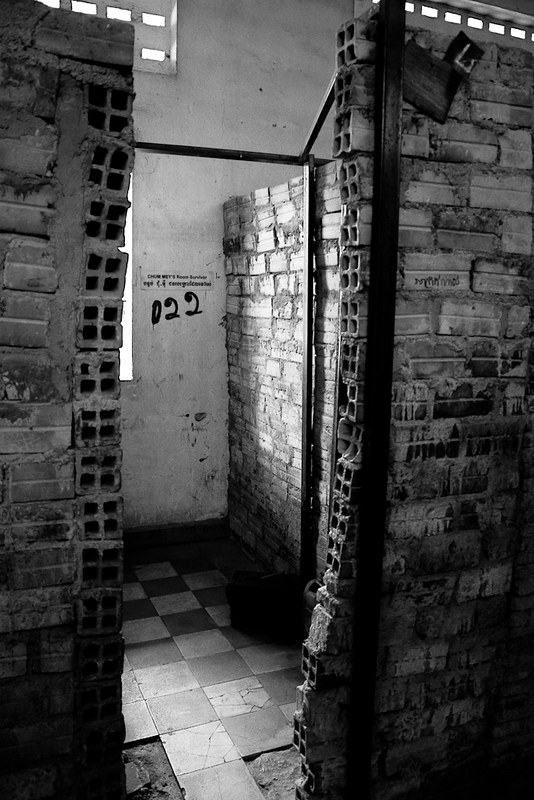
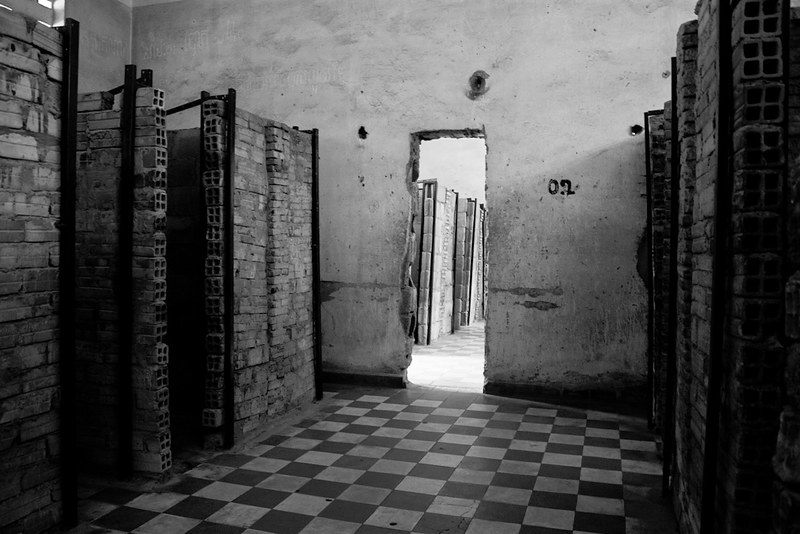
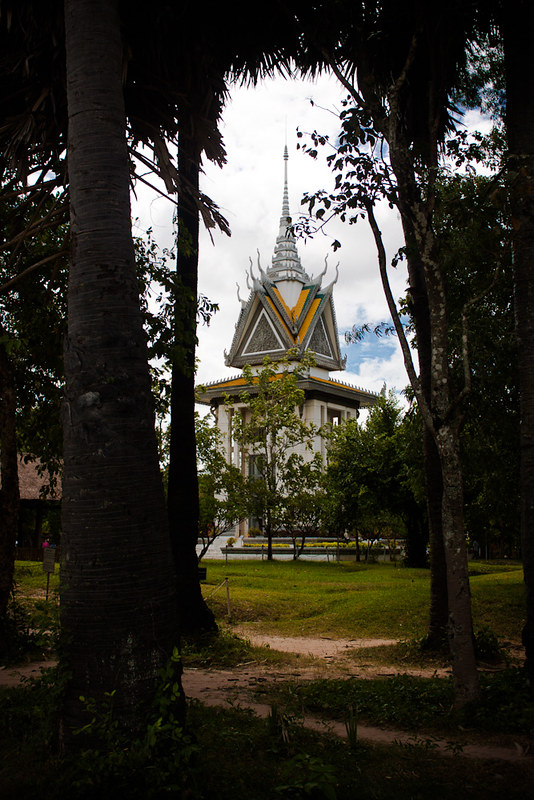

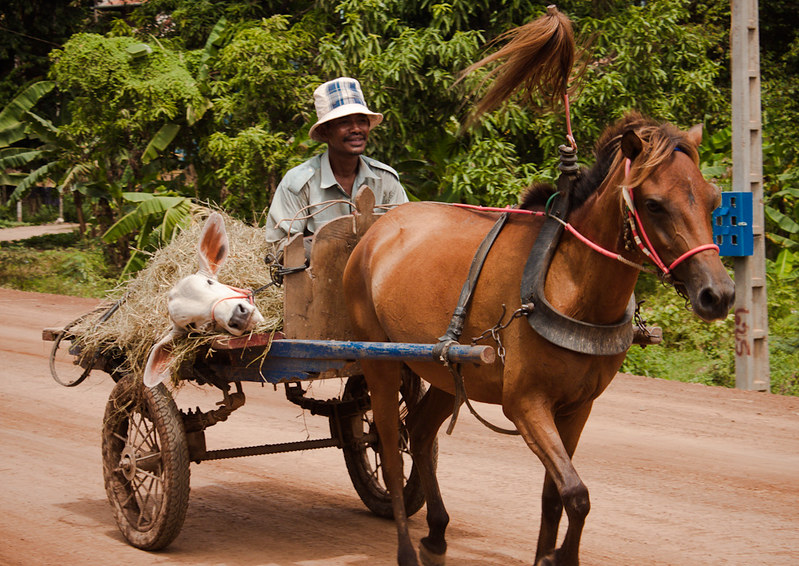

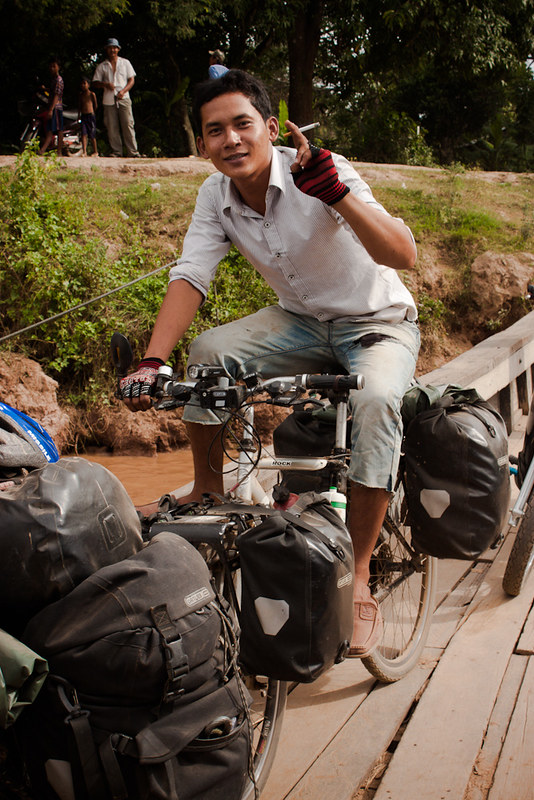

Cambodia looks beautiful. It has a incredibly sad past, but certainly a lot more to it than that.
ReplyDeleteReally enjoyed reading about it, and your photos are great.
Vietnam we did find tough and not so friendly, but Laos was the best time of our trip, and China we loved too, so you have plenty to look ahead to.
We did not start the cycling until Vietnam, so can't say much for the roads of China except there are a lot of motorbikes and the roads are huge and busy in cities; but it's all very slow moving, and I would call them mope-heads rather than motorbikes (as the locals call them)- which we regularly overtook on pedal power.
Laos was the most beautiful for us, but some roads could be very bumpy (and we had suspension...) but the view, and sparse (and not so horn friendly) traffic more than makes up for it.
Christina and Hattie
http://www.littletravellingfeat.org/
p.s our friend Robbie cycled from Bejing to Laos, his blog is... http://globalguitarcycle.com/
Fantastic account Robin - completely agree with all you say about Cambodia, and it was very much our reaction too - ie that in spite of its horrendous history, its people possess a kindness and happiness which is more than just skin deep but seems to imbibe their spirit. We found the same in Laos - not so much in Vietnam, although there a lively capitalism seems to be the overarching character trait rather than anything else more sinister. Looking forward to your account of Vietnam - please make sure to add your review of Danang!
ReplyDelete